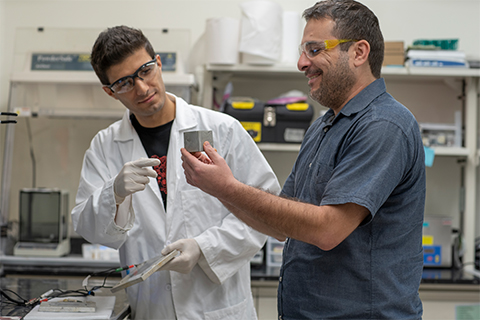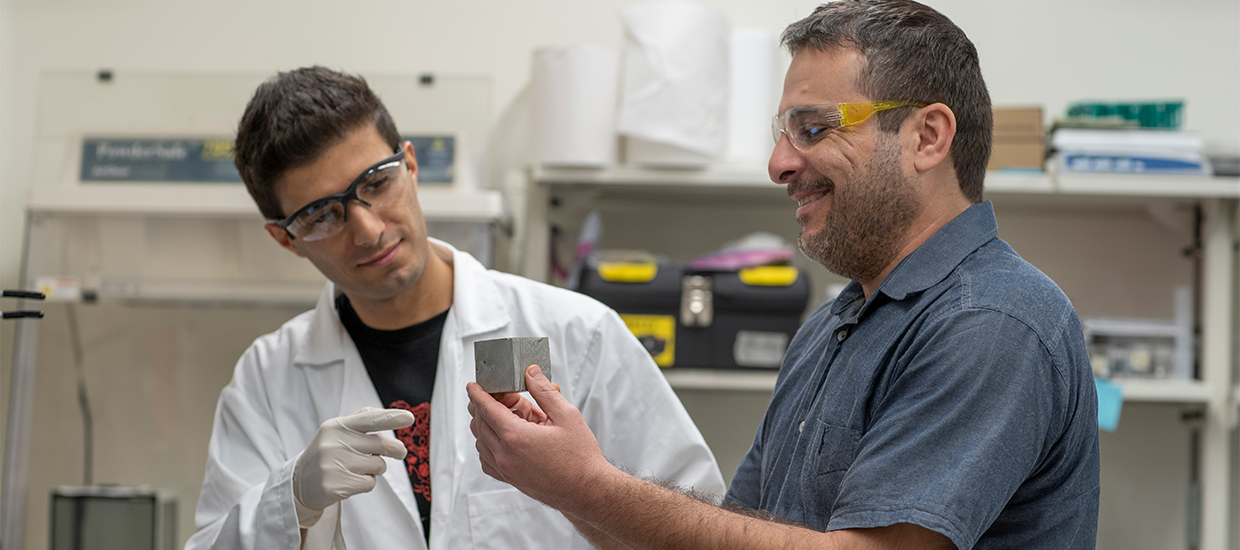Faculty mentors
The proposed research projects are collaborative and cross multiple disciplines including engineering, chemistry, marine sciences and biology, all designed to emphasize the importance of collaboration to the students. Each REU student will be mentored by two faculty. The two-faculty mentor model constitutes a crucial aspect of the project aimed at providing the students with complementary and different perspectives necessary to address issues related to coastal resilience.
| Faculty Mentor |
Field |
Research Interests |
| Esber Andiroglu |
Architectural Engineering |
Smart sensing technology for resilient water infrastructure |
| Kevin Collins |
Biology |
Bacteria-induced bio-mineralization for engineering materials applications |
| Ali Ghahremaninezhad |
Civil Engineering |
Bio-inspired approaches for sustainable and resilient infrastructure materials |
| James Giancaspro |
Civil Engineering |
Durability and long-term behavior of cementitious materials |
| Maribeth Gidley |
Public Health |
Epidemiologic and beach management studies that relate microbial water quality with human health |
| Brian Haus |
Ocean Sciences |
Sea-coast interactions in extreme winds, wave dynamics, turbulence and coastal structure design |
| Marc Knecht |
Chemistry |
Biomimetic approaches for the fabrication of materials via peptide-based methods |
| Diego Lirman |
Coastal Ecosystem Sciences |
Disturbance of coastal ecosystems |
| Ramin Moghaddass |
Industrial Engineering |
Data-driven decision making under uncertainty and dynamic environments, and energy grid condition monitoring |
| Antonio Nanni |
Civil Engineering |
Innovative composites for infrastructure rehabilitation |
| Landolf Rhode-Barbarigos |
Civil Engineering |
Adaptive and active structures for coastal structure resilience and sustainability |
| Luis Ruiz Pestana |
Computational Sciences |
Computational modeling for infrastructure materials |
| Helena Solo-Gabriele |
Environmental Engineering |
Understanding the relationships between the environment and health, and contaminants fate and transport |
| Prannoy Suraneni |
Civil Engineering |
Materials science of alternative cementitious materials |
| Nick Tsinoremas |
Computational Sciences |
Informatics and computational approaches in medicine |
| Jie Xu |
Electrical Engineering |
Network security and machine learning |
Anticipated Research Projects
Typical research projects are discussed below and identify the specific topical areas that are anticipated during the summer. However, the structure of the research will be mutually agreed upon by each faculty advisor and REU participant. For example, the student may:
- Propose their own original research idea related to the faculty advisor's research thrust
- Carry out a mini-project that the faculty advisor carves out from a larger, ongoing project
- Initiate a new project such as a pilot study proposed by the advisor
- Merge into an existing research project
The structure of each student's research will be established in the month of May prior to the REU on-site activities. Videoconferences will be scheduled in mid- and late-May between the faculty advisors and student. These virtual meetings will educate and allow them to formulate a research plan that will be presented when the site activities commence in June. Students will be trained in the lab alongside other students. Thus, it is not necessary for students to have in-depth knowledge of the research content below.
|
Project 1: A bio-inspired self-healing approach for infrastructure cementitious materials
Faculty: Ghahremaninezhad (Civil Engineering Materials) and Collins (Biology)
Summary: Concrete and other cementitious materials are intrinsically brittle and prone to fracture under mechanical and environmental conditions. Therefore, innovative materials with the capability to self-heal after fractures are highly desirable in coastal infrastructure. Students will examine the interactions between hydrogels and a hydrating cementitious matrix using optical and scanning electron microscopy (SEM), and material characterization techniques. Then, the students will investigate the crack filling and crack binding of hydrogel encapsulated bacteria in cementitious materials using mechanical testing and scanning electron microscopy. The insights obtained from this research will help in the development of safe and reliable design guidelines for high performance and smart cementitious materials.
|
|
|
Project 2: A genetically-engineered approach for sustainable cement-based materials
Faculty: Ghahremaninezhad and Giancaspro (Civil Engineering) and Knecht (Biochemistry)
Summary: Nature has created biological materials with hierarchical microstructure and superior mechanical and functional properties. This is achieved in nature through certain biomolecules with specific structures and functionalities directing the growth, microstructure and macroscopic performance of biological materials, such as nacre of abalone shells, bones and sea urchins. Students will investigate the effect of biomolecules on the microstructure of calcium-silicate-hydrate using advanced microcopy and nanoindentation techniques. The research has the potential to enable significant progress in engineering innovative infrastructure materials with improved sustainability and reduced carbon footprint.
|
|
|
Project 3: Understanding chemo-mechanical mechanisms of damage by the attack of salts on cementitious materials
Faculty: Ruiz Pestana (Computational Sciences and Civil Engineering)
Summary: Damage induced by the crystallization of dissolved salts is a major contributor to the deterioration of concrete-based coastal infrastructure. Similar to freeze-thaw cycles in cold climates, repeated crystallization of dissolved salts confined into cement pores produce internal stresses that exceed the tensile strength of the material and lead to damage. Students will use molecular dynamics simulations to simulate the crystallization of supersaturated aqueous salt solutions in solution and under a variety of nanoconfinement conditions relevant to cementitious materials. This research will increase our understanding of the coupled chemical-mechanical processes underling the degradation mechanisms of concrete infrastructure materials, which is needed in the development of extremely durable concrete.
|
|
|
Project 4: Structural morphogenesis of artificial coral reefs for shoreline protection
Faculty: Rhode-Barbarigos (Civil Engineering) and Haus (Marine Sciences)
Summary: Coral reefs have been shown to mitigate the impacts of climatic hazards in an efficient manner. They protect the shoreline from erosion and flooding by functioning like low-crested breakwaters, reducing wave energy through wave-breaking action and friction. Both effects are linked to their growth and their self-generated carbonate structure (i.e. their skeleton). Students will study the influence of physical parameters at the intersection between ecology and engineering (i.e. reef profile, size and configuration, stability, material composition, and surface texture) through measurements of the wave height, water velocity and pressure through physical testing of small rigid models in the SUrge STructure Atmosphere INteraction (SUSTAIN) wind-wave tank. The results from this research will set the stage for a new design paradigm to develop novel engineering solution for coral restoration to enhance coastal community resilience against extreme climatic events.
|
|
|
Project 5: Investigation of 'coralphilic' cementitious materials
Faculty: Suraneni (Civil Engineering) and Lirman (Marine Sciences)
Summary: Coral outplanting using cementitious materials is rapid and scalable. Cement-based materials can significantly vary in their chemistry, and the chemistry can be exploited to ensure compatibility with corals. However, the impact of the chemistry of cementitious materials on coral growth and survivorship is unclear. Students will study various cementitious paste mixtures with varying chemistries. The growth and density of Acropora corals on small-scale slabs made with these cement pastes will be monitored. Corals will be fractured in compression and their microstructure will be evaluated using electron microscopy and x-ray tomography to develop links between the growth environment, microstructure, and macrostructural strength. This research will contribute to the development of artificial coral reefs as a self-sustainable, regenerative, adaptive, and cost-effective natural line of defense to protect the coastal infrastructure.
|
|
|
Project 6: Retrofitting coastal bridges using innovative methodologies
Faculty: Nanni (Civil Engineering) and Haus (Marine Sciences)
Summary: As part of the coastal infrastructure, bridges play an important role for the economic development and safety of transportation. Bridges are not only critical to everyday traffic flow, but are a cornerstone for evacuation and recovery emergencies after natural and human-made disasters. Students will gain research experience in the deployment of resilient and sustainable technologies for concrete coastal infrastructure, and the evaluation of the performance and design processes of technologies and systems when applied to field projects. This experience would allow undergraduates to instrument and monitor different structural components of a bridge to better understand how concrete and composite materials behave over time, while being able to correlate field data with available laboratory results. The results from this research will permit the development of design guidelines for implementation of innovative technologies and material systems to mitigate the damage resulting from corrosion.
|
|
|
Project 7: Transport and growth of bacteria at recreational beaches
Faculty: Solo-Gabriele (Environmental Engineering) and Gidley (Public Health)
Summary: Maintenance of "healthy", high quality beaches is imperative to coastal infrastructure and resilience. Beaches that are unusable because of contamination will contribute towards the decline of a region, thereby making it difficult to rebound from adverse conditions. This project focuses on understanding the mechanisms of bacterial transport in beach environments. Students will be engaged in field and laboratory experimentation focused on assessing the levels of bacteria in aerosolized marine water. This research will aid in understanding the potential human health impacts under different environmental conditions from inhalable microorganisms released from water and beach sand.
|
|
|
Project 8: Smart earth and water networks: use of smart sensing technology and citizen collaboration in response to sea level rise
Faculty: Andiroglu (Architectural Engineering) and Tsinoremas (Center for Computational Sciences)
Summary: In response to the rise in sea level, various flood mitigation and environmental preservation efforts have been envisioned including raising roadways and land, installing pumps, and creating new storm water collection networks. Students will be engaged in research centered around data collection and understanding impacts of ground saturation, interaction of pollutants transported by surface water runoff with land, water, air and their connection to human health in coastal communities. Students will (i) identify sea level rise risks and impacts on coastal infrastructure through field surveys and GIS mapping tools, (ii) defining test parameters and data needs, (iii) deploying selected smart sensors, and (iv) collecting dynamic data from the smart sensors. The results can help researchers develop threat mitigation models to improve the resilience of water infrastructure networks in coastal communities during extreme weather events.
|
|
|
Project 9: Simulation framework for grid resiliency in disaster recovery in smart and connected communities
Faculty: Moghaddass (Industrial Engineering) and Xu (Computer Engineering)
Summary: The objective of this project is to utilize and optimally coordinate the operations of diverse distributed energy resources (DERs), storage units, and fleets of electric vehicles within communities/cities to continuously provide electricity to critical infrastructures and residential buildings after natural disasters. Students will develop a simulation testbed mimicking communities' resources and vulnerabilities on a pilot scale. The main modules in the simulation model will be the generating source module, the storage module, the load module, the power market/environment module, and smart control and aggregator module. The findings from this research are expected to help key decision-makers for the electric grid infrastructure to identify optimal adaptation or mitigation strategies.
|
|





